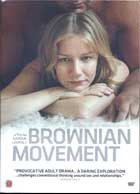
Brownian Movement 2011
Distributed by First Run Features, 630 Ninth Avenue, Suite 1213, New York, NY 10036; 212-243-0600
Producer n/a
Directed by Nanouk Leopold
DVD, color, 97 min.
College - General Adult
Films, Sexuality
Date Entered: 08/27/2014
Reviewed by Oksana Dykyj, Head, Visual Media Resources, Concordia University, MontrealDutch director Nanouk Leopold’s Brownian Movement considers a woman’s drive to act upon impulses that exhibit themselves in sexual acts. It may not be entirely clear to the viewer, nor to Charlotte herself (Sandra Hüller) a medical doctor we follow throughout the film, whether these impulses are sexual in nature or whether they originate in another type of impulse that emerges in the guise of sexual acts. In scientific terms, Brownian movement refers to the irregular motion of particles suspended in fluid or gas. Leopold’s film follows Charlotte’s actions as they zigzag from work to the apartment where she has sexual encounters with patients she meets at her hospital workplace, and then to her home where she has a loving relationship with her husband Max (Dragan Bakema) and son Benjamin (Ryan Brodie). She appears to function as if she were suspended in a form of gas while the languorous but methodical exposition of her psyche eventually leads to a breakdown and resolution. Charlotte’s double life is calm and controlled in all three worlds she inhabits. The hospital and lab are pure white worlds; the apartment she rents for her encounters is austere and generically beige, while her home is a contrast of light and dark, warmth and clutter.
The film is very formal in structure and exposition: It is divided into three narrative parts, each one defining events that crest before the beginning of the next part. It also uses space in a very formal fashion by making it define the characters. Apart from having a very specific vision about the film style, Leopold’s choice of working with cinematographer Frank van der Eeden and production designer Elsje de Bryijn, has produced a film that is both reflective and unsettling. In the first part when Charlotte fluidly moves between her three environments, she is shown dominating the frame in terms of the camera being primarily focused on her rather than on other characters. The second part consists of her therapy sessions and assessment as well her presence at the Medical Disciplinary Tribunal to determine her future. In this section, as she refuses to reveal why she chose the men she did, she is bathed in light and placed in the center of her space while the therapist is essentially off-screen and her husband is only shown off center while she still looms in the frame. In the third part, time has passed and her environment has changed, she is now in a suburban house in India with Max, their son Benjamin and a set of young twins. Her new home is a cross between the look of her previous environments. The light has changed from white to more golden and we are shown shots displaying exquisite framing of space and characters within it.
The film’s visuals define its narrative. The viewer is allowed the time to contemplate and think about the meaning of each beautifully composed shot. Perhaps, some may find the film a tad ponderous, and it may be at times, but the decision to give weight to Charlotte’s actions through imposing shots of her luminous façade create a singular component to her personality as it is both revealed and at the same time concealed from us. Light has a way of doing both. Recommended for film studies and anyone interested in independent films.